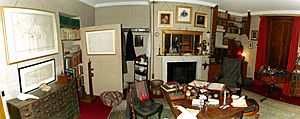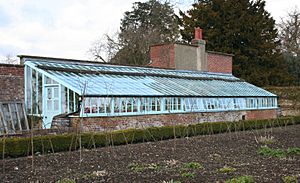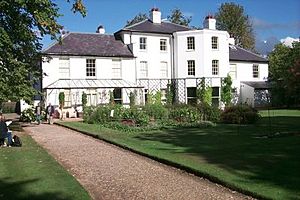Down House facts for kids
Quick facts for kids Down House |
|
|---|---|
 |
|
| Location | Luxted Road, Downe, BR6 7JT |
| Area | London Borough of Bromley |
| Owner | English Heritage |
|
Listed Building – Grade I
|
|
| Official name: Down House | |
| Designated | 31 May 1954 |
| Reference no. | 1038325 |
| Lua error in Module:Location_map at line 420: attempt to index field 'wikibase' (a nil value). | |
Down House was the home of a famous English scientist, Charles Darwin, and his family. It was here, in this house and garden, that Darwin developed his amazing idea about how living things change over time, called evolution by natural selection. He had already started thinking about this theory before he moved to Down House.
This important building is located in a quiet village called Downe, about 14 miles (23 km) southeast of London. When Darwin moved here in 1842, the village was called Down. Today, Down House is looked after by English Heritage and is open for everyone to visit.
Contents
History of Down House
Early Days of the House
The land where Down House stands was first sold in 1651. It's believed that the first farmhouse was built around this time. Over the years, the property changed hands many times.
In 1778, a businessman named George Butler bought the property. He is thought to have made the house bigger and better. After he passed away, the house continued to be sold to different owners. In 1837, the house was left empty for two years before Charles Darwin found it.
Darwin's Life at Down House
In 1841, Charles Darwin and his wife, Emma Darwin, were looking for a new home. Their London house felt too small, and they wanted to live in the countryside away from the city's noise and pollution. They also had two young children.
In July 1842, Charles and Emma visited Down House. It was a quiet village, far from busy roads. The house itself was a three-story building. It had a good study for Darwin to work in, a dining room, a drawing room, and many bedrooms.
They decided to buy the house for about £2,200. Emma moved in on September 14, 1842, and Charles joined her three days later.
Changes to the House and Garden
Darwin made many changes to Down House and its grounds. In 1843, he added a large bay window to the west side of the house. This made the drawing room and the rooms above it bigger, giving them better views and more light. He also made the garden more private by lowering the nearby lane and building new walls.
All of Darwin's remaining children were born at Down House. The family grew with the births of George in 1845, Francis in 1848, and Horace in 1851, among others.
Between 1845 and 1846, Darwin improved the service area of the house, adding a butler's pantry and a schoolroom. He also rebuilt the outdoor buildings.
A new part was added to the north end of the house in 1858. This created a large new drawing room, which became a comfortable family space. The old drawing room became a new dining room.
Darwin was very interested in plants. In 1863, he had a new heated greenhouse built. He spent 16 years growing carnivorous plants like sundews in this greenhouse. He even fed them things like roast beef and boiled egg to study them! This research helped him write his important book, Insectivorous Plants.
In 1877, a new billiard room was added, and the entrance to the house was changed. The new billiard room later became Darwin's new study in 1881. The old study, where he wrote his famous book On the Origin of Species, became a smoking room.
Charles Darwin passed away at Down House on April 19, 1882, at the age of 73. Emma Darwin also passed away there in 1896.
The Sandwalk: Darwin's Thinking Path
In 1846, Darwin rented a strip of land next to his property and had it planted with trees. He called it the Sandwalk Wood. He created a gravel path, known as the "sandwalk," around its edge.
Darwin would walk several laps on this path every day. It was his special place for exercise and for thinking without interruptions. He even placed small stones along the path. Each time he passed a stone, he would kick it to the side. This way, he didn't have to count his laps and could focus on his thoughts. The Sandwalk was also a fun place for his children to play.
Down House After Darwin
After the Darwin family, Down House became a girls' boarding school in 1907. The school started with just a few students but quickly grew. It stayed there until 1922 when it moved to a larger location. The school is still called Downe House School today.
From 1929, Down House became a museum dedicated to Charles Darwin. A surgeon named Sir George Buckston Browne bought the house and gave it to the British Association for the Advancement of Science. He wanted to make sure it would be preserved forever as a memorial to Darwin.
In 1996, English Heritage took over Down House. They restored it with help from various groups and reopened it to the public in 1998. In 2009, a new exhibition was created on the first floor, telling the story of Darwin's life and work.
Down House and its gardens have been considered for a World Heritage Site by the UK government because of their importance to science and history.
Visiting Down House
Down House, its garden, and grounds are open to the public for most of the year. You can visit daily from April to October, and on weekends from November to March.
You can reach Down House by public transport from central London. The 146 bus from Bromley North railway station stops nearby at Downe Village. The R8 bus from Orpington railway station also stops outside Down House on request.
See also
 In Spanish: Down House para niños
In Spanish: Down House para niños
- The Mount, Shrewsbury
- Historic houses in England
- List of English Heritage properties
- Museums in England





